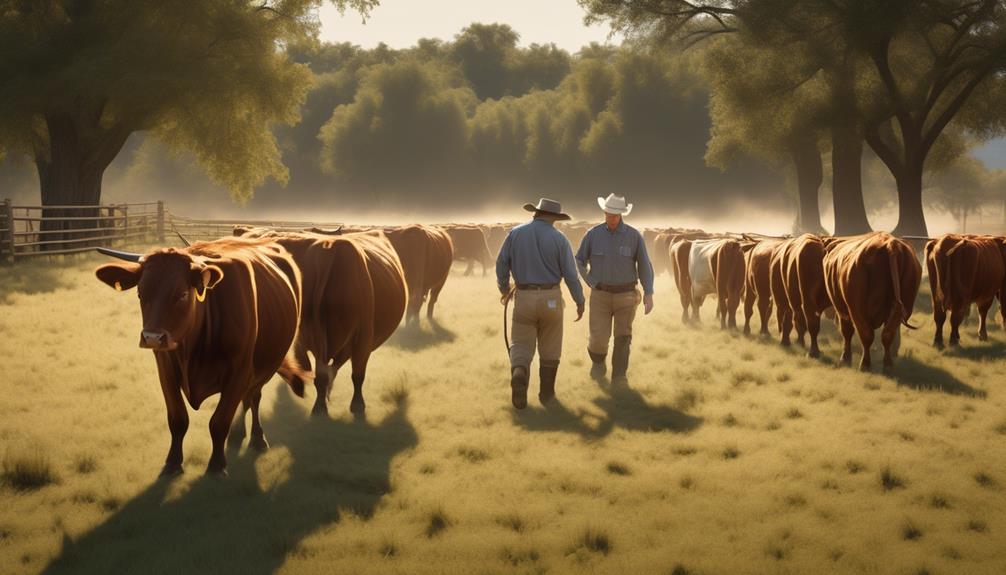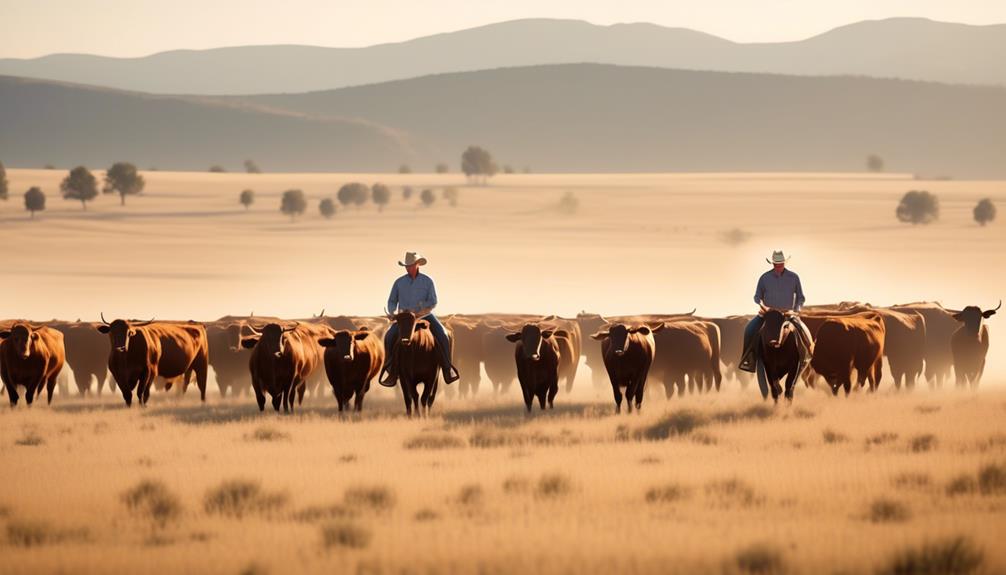Why Use Gentle Cattle Herding Methods?
Imagine a herd of cattle as a delicate ecosystem, where each animal's behavior influences the others. Just like a pebble tossed into a pond creates ripples that spread outward, the way you handle your cattle can have a lasting impact on their well-being and productivity.
But why should you bother with gentle herding methods? Well, there's more to it than just keeping the peace in the pasture. It's about understanding the psychology of these animals and using that knowledge to your advantage.
Benefits of Gentle Herding

By gently herding your cattle, you can reduce stress and improve their overall welfare. Minimizing anxiety and promoting calmness are essential for the well-being of your cattle. When you employ gentle herding methods, you create a more tranquil environment for your animals. This has a direct impact on their mental and physical health. By avoiding loud noises, sudden movements, or aggressive behaviors, you can create a space where your cattle feel safe and secure. This, in turn, leads to reduced stress levels and a calmer demeanor among the herd.
Additionally, gentle herding methods can result in improved productivity. When cattle are less stressed, they're more likely to exhibit natural feeding and resting behaviors, which are crucial for their overall health. Calm and content cattle are also more receptive to handling, making routine tasks such as veterinary care and hoof trimming easier and safer for both the animals and the handlers. By minimizing the stress associated with these activities, you can also reduce the risk of injuries to both the cattle and the workers.
Furthermore, promoting calmness through gentle herding methods can enhance the quality of the meat and dairy products derived from the animals. Studies have shown that stress and anxiety can negatively impact the flavor and texture of meat, as well as the composition of milk. By prioritizing the well-being of your cattle, you aren't only benefiting the animals themselves but also potentially improving the quality of the products they provide.
Understanding Cattle Behavior
To effectively manage your cattle, it's essential to understand their behavior and natural instincts. Cattle have instinctual behaviors that can significantly impact the effectiveness of herding and handling. Understanding these behaviors is crucial for successful cattle management.
One key instinctual behavior to grasp is the herd mentality. Cattle are social animals that prefer to stay in groups. Separating them from the herd causes stress and anxiety, affecting their behavior and productivity. Effective communication techniques are vital when working with cattle. Using low-stress handling methods such as body language, positioning, and gentle movements can help you communicate with your cattle more effectively. Understanding how cattle perceive and respond to your actions is essential in reducing stress and achieving better results.
Moreover, understanding cattle behavior also involves recognizing their flight zone. Cattle have a natural flight zone, which is the distance at which they start to feel uncomfortable and move away from a perceived threat. By understanding and respecting this flight zone, you can handle and move your cattle more efficiently. Additionally, being aware of their body language, vocalizations, and other communication cues can help you better understand and respond to their needs.
Minimizing Stress and Injuries

Minimize stress and injuries by implementing gentle cattle herding methods and being mindful of their natural instincts and flight zone. When herding cattle, reducing anxiety and preventing accidents is crucial for both the animals and the handlers.
Here's how you can achieve this:
- Understand Their Flight Zone: Cattle have a natural flight zone, which is the space surrounding them that, when encroached upon, causes them to move away. By understanding and respecting this flight zone, you can minimize stress and prevent unnecessary agitation.
- Use Low-Stress Handling Techniques: Gentle, low-stress herding methods help in reducing anxiety among cattle. This involves moving them calmly and patiently, without loud noises or abrupt movements, to prevent them from getting startled or panicked.
- Proper Herding Equipment and Facilities: Utilize well-designed herding facilities and equipment to minimize the risk of injuries. Well-constructed pens, alleys, and chutes can help guide cattle more smoothly, reducing the likelihood of accidents occurring during herding.
Building Trust With Cattle
When working with cattle, establishing trust is essential for effective herding and handling. Building trust with cattle is crucial to ensure smooth and efficient handling. An effective way to achieve this is through positive reinforcement.
By using positive reinforcement techniques, you can create a positive association with handling and herding activities, which helps to build trust and cooperation with the cattle.
Positive reinforcement involves rewarding desired behaviors to encourage their repetition. When working with cattle, this can be achieved by using treats, gentle pats, or soothing verbal cues to reward them for exhibiting the desired behavior, such as moving in the intended direction or remaining calm during handling. Consistently rewarding these behaviors helps the cattle to understand what's expected of them and builds their confidence in your interactions.
Another important aspect of building trust with cattle is understanding their individual personalities and behavior patterns. Each animal has its own temperament and preferences, and taking the time to observe and understand these traits can go a long way in establishing trust.
Improving Animal Welfare

As you work on building trust with cattle through positive reinforcement and understanding their individual personalities, consider the impact of these efforts on improving animal welfare. By prioritizing gentle cattle herding methods, you're actively contributing to the well-being of the animals in your care.
Here's how your approach can lead to better animal welfare:
- Reduced Stress: Your considerate and gentle approach to animal handling helps minimize stress in cattle. When cattle experience less stress, they're healthier, more content, and less prone to illness. By managing stress effectively, you're promoting the overall welfare of the herd.
- Enhanced Physical Health: Through your compassionate and respectful herding techniques, you're contributing to the physical health of the cattle. A calm and stress-free environment can lead to better weight gain, improved reproductive performance, and reduced risk of injuries.
- Positive Behavioral Outcomes: Your focus on gentle cattle herding methods can lead to positive behavioral outcomes in the animals. When cattle are handled with care and understanding, they're more likely to exhibit relaxed and cooperative behaviors, leading to a safer and more harmonious environment for both the cattle and the herders.
Enhancing Productivity and Efficiency
To boost productivity and efficiency in cattle herding, prioritize clear communication and consistent training methods to streamline the handling processes. By enhancing communication between herders and implementing standardized training techniques, you can effectively reduce confusion and errors during herding activities. This clarity and consistency will lead to a more efficient operation overall.
Additionally, employing gentle herding methods can contribute to increasing yields. When cattle are handled with care and minimal stress, they're more likely to remain healthy and produce higher quality products. Reduced stress levels can also lead to improved weight gain and reproductive success in the herd, ultimately contributing to higher yields.
Streamlining operations through gentle herding methods can have a significant impact on the overall efficiency of your cattle herding business. By minimizing the time and effort required to manage and move the cattle, you can allocate resources more effectively and maximize productivity. Furthermore, a calm and content herd is easier to manage, reducing the likelihood of injuries to both the animals and the herders. This not only enhances the efficiency of daily operations but also minimizes potential setbacks caused by injuries or disruptions.
Implementing Low-Stress Handling Techniques

Consider implementing low-stress handling techniques to ensure the well-being and productivity of your cattle herd. By reducing anxiety and promoting calmness, you can create a more efficient and contented environment for your animals. Here are three key ways to implement low-stress handling techniques:
- Proper Training: Train yourself and your staff in low-stress cattle handling techniques. Understand the behavior and psychology of cattle to anticipate their reactions and minimize stress during handling.
- Facility Design: Optimize your cattle handling facilities to minimize stress. Use curved chutes and open spaces to allow for natural movement. Ensure that lighting, flooring, and noise levels are conducive to a calm environment.
- Gentle Herding: Utilize low-stress herding methods such as maintaining a slow, steady pace and using flight zones to guide the movement of the herd. Avoid aggressive behaviors and sudden movements that can startle the cattle.
Implementing low-stress handling techniques not only benefits the well-being of your cattle but also enhances their productivity. Calm and contented cattle are less prone to illness and injury, leading to improved weight gain and reproductive performance.
Additionally, reduced stress levels can lead to better meat and milk quality, ultimately benefiting your bottom line. By prioritizing the implementation of low-stress handling techniques, you can create a more harmonious and efficient environment for your cattle herd.
Creating a Positive Work Environment
To maintain your cattle's well-being and productivity, fostering a positive work environment for your staff is crucial. Positive reinforcement and effective communication are key elements in creating this environment.
Implementing positive reinforcement techniques, such as providing praise and rewards for good work, can motivate your staff to perform their tasks with enthusiasm and dedication. This not only benefits the well-being of your cattle but also contributes to a more harmonious and efficient work environment.
Effective communication is also vital in creating a positive work environment. Encouraging open dialogue among your staff members allows for the exchange of ideas, feedback, and concerns. This can lead to a better understanding of the tasks at hand and the overall goals of cattle herding. Additionally, clear communication helps prevent misunderstandings and conflicts, promoting a more positive atmosphere among your team.
Furthermore, fostering a positive work environment can lead to increased job satisfaction and reduced stress for your staff. When employees feel valued and supported, they're more likely to take pride in their work and approach their responsibilities with care and diligence. As a result, this can have a direct impact on the well-being of your cattle, as the handling and care they receive from content and motivated staff will be of a higher standard.
Frequently Asked Questions
Can Gentle Herding Methods Be Used for All Types of Cattle, Including Those With Aggressive or Unpredictable Behavior?
Yes, gentle herding methods can be used for all cattle types, including those with aggressive or unpredictable behavior. Handling aggressive cattle requires behavior modification techniques, training, and safety measures to ensure effective and safe herding.
How Do Gentle Herding Methods Compare to Traditional Herding Techniques in Terms of Time and Labor Efficiency?
When herding cattle, gentle methods are often more time and labor efficient compared to traditional techniques. They reduce stress on the animals, making them easier to move and handle, ultimately saving you time and effort.
Are There Any Potential Drawbacks or Challenges Associated With Implementing Gentle Herding Methods on a Large Scale?
Implementing gentle herding methods on a large scale can pose challenges. Understanding animal behavior and ensuring labor efficiency are crucial. Adequate training and infrastructure are needed to overcome these obstacles and make the approach successful.
What Are the Long-Term Effects of Using Gentle Herding Methods on the Overall Health and Well-Being of the Cattle?
Using gentle herding methods has positive effects on livestock well-being, reducing stress and improving overall health. It also influences animal behavior positively and enhances herding efficiency, creating a more harmonious and sustainable environment for the cattle.
Are There Any Specific Training or Certification Programs Available for Those Looking to Learn and Implement Gentle Herding Methods?
Looking for training programs to learn gentle herding methods? There are various certification options available for those interested in implementing these methods, providing the knowledge and skills needed to ensure the well-being of the cattle.
Conclusion
So, next time you're herding cattle, remember the benefits of gentle herding. By understanding and minimizing stress, building trust, and improving animal welfare, you can enhance productivity and create a positive work environment.
Implementing low-stress handling techniques isn't only beneficial for the cattle, but also for your own efficiency and well-being.
So, make the switch to gentle herding methods and see the positive impact it can have on your cattle and your work.
